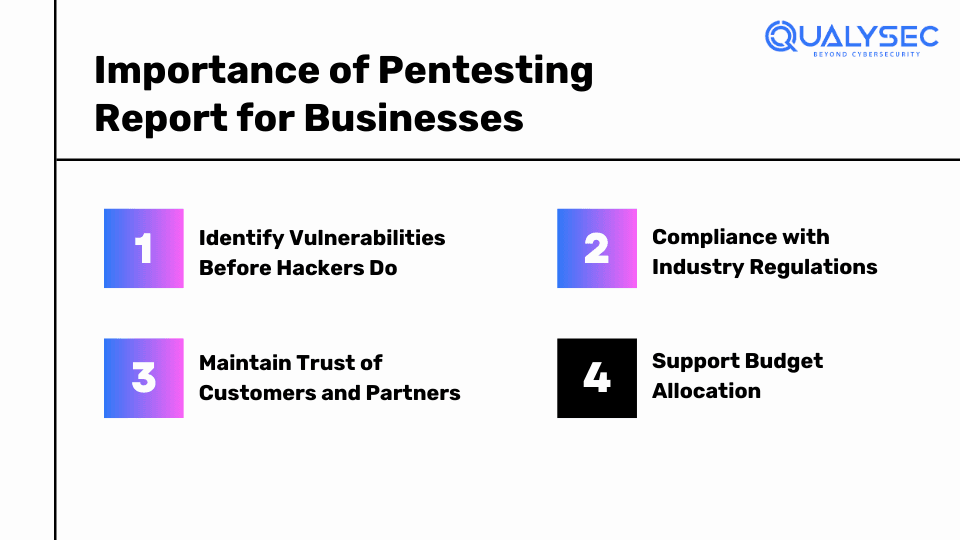A pentesting report contains the summary and results of a pen test. A pen test or penetration testing is a process of simulating real cyberattacks on applications or networks to find any vulnerabilities present in them. Companies appoint pen test service providers to test their security defense and find any weak points that hackers or cyber attackers could exploit. A penetration testing report will include the vulnerabilities found by the pen testers and steps to fix the vulnerabilities.
As per a recent report, over 26,447 vulnerabilities were reported in 2023, surpassing the previous year by 1500 CVEs (Common Vulnerabilities and Exposures). Just think how much loss these companies would have faced if these vulnerabilities were exploited by hackers!
In this blog, we will get an in-depth analysis of pentesting reports, why it is important for businesses, and the components present in them.
What is a Pentesting Report?
A pentesting report is a document that includes the findings of the security assessment conducted using various penetration testing techniques. The report should include information about the test’s scope, and objectives, and a summary of the findings. It should also have recommendations or steps for remediation.
Penetration test reports are used to improve the organization’s security posture by identifying vulnerabilities and providing guidance on how to fix them. Additionally, they can also be used to comply with industry regulations and provide evidence during a data breach.
While conducting a penetration test, organizations should ensure that the pen testers understand your goals and provide a report that meets your needs. make sure to ask for sample reports before choosing the right penetration testing service provider.
Want to see a sample penetration testing report right now? You just have to click on the link below and download our pen report in just a matter of seconds.
Latest Penetration Testing Report

Why Pentesting Report is Important for Businesses
For businesses, a pentesting report is equally important for developers, stakeholders, and clients. Security experts prepare vulnerability assessment and penetration testing reports that include the vulnerabilities they found while testing the application and the steps to fix them. Here are some of the benefits of penetration testing reports:

1. Identify Vulnerabilities Before Hackers Do
Even a small vulnerability can result in a huge cyber attack on your business. Hence, before hackers find and exploit vulnerabilities, you find and fix them. Pentesting reports mention the vulnerabilities testers found during their assessment and also steps to fix them. A detailed report can reduce the time taken to complete the remediation process.
2. Compliance with Industry Regulations
Many industry regulations have strict rules on protecting customer data, for example, GDPR, HIPAA, SOC 2, PCI DSS, and more. These rules require businesses to conduct security testing for their products and services so that sensitive information is protected. Not adhering to these rules may result in legal penalties and huge fines. A pentesting report helps comply with these regulations, thus saving the organization from big embarrassment and fines.
3. Maintain Trust of Customers and Partners
Whether small or large, businesses need to maintain relationships with clients, customers, stakeholders, and partners, they expect the business to keep their information and details confidential. A pentesting report can be used to maintain that trust, providing that you care about their data and make security your top priority. A pentest report generator can streamline the creation of these reports, ensuring accuracy and consistency.
Moreover, pen testers also perform retests before providing the final report and security certificate. This is because they need to make sure that the found vulnerabilities were properly fixed or not. A pen test report is proof that you have successfully conducted security testing and that your organization is now secure.
4. Support Budget Allocation
A pen test report helps the organization plan its budget allocation for cybersecurity measures. Every business has a different way of prioritizing their resources and a detailed report from pen testers helps them understand their crucial resources that need further security improvements. With a detailed report, the technical team can address the application’s weak points that require urgent attention.
Want to secure your business from hackers and cyber threats? Qualysec Technologies offers process-based penetration testing with accurate and simple reports. We will help your developers with the remediation process over consultation calls. We even retest your applications to check whether the remediation steps worked or not! Contact us for your cybersecurity needs!
Talk to our Cybersecurity Expert to discuss your specific needs and how we can help your business.
When is a Pentesting Report Used
Organizations not only use pentesting reports to identify and fix vulnerabilities before hackers but also assess the effectiveness of their security controls. Additionally, penetration testing results helps them understand which areas are most vulnerable and what steps they need to improve them.
Organizations can use a pentesting report for:
- After conducting penetration testing on a system or network
- When vulnerabilities need to be documented and addressed
- To provide insights into the security posture of the organization
- To guide remediation efforts and prioritize fixes
- To ensure compliance with regulatory requirements and industry standards
- To enhance overall cybersecurity resilience and protect against cyber threats
Components of a Pentesting Report
A well-written penetration testing report will provide clear and applicable recommendations that can be used to improve the security system of an organization. Utilizing a penetration testing reporting tool, the pentesting report should be easy to understand for technical teams and non-technical departments.
The following are the components of a good penetration testing report:

1. Executive Summary:
This part provides a brief overview of the pen test goals, the areas it covered, and the vulnerabilities found. It also offers clear recommendations for addressing these vulnerabilities to improve security.
2. Introduction:
The introduction explains why the penetration test was conducted and what the organization hoped to learn from it. It sets the stage for the rest of the report by outlining the goals and scope of the assessment.
3. Methodology:
This section provides detailed insights into how the penetration test was carried out. It explains the tools, techniques, and approaches used to identify vulnerabilities. Additionally, the severity of each vulnerability and its potential impact on the organization is also discussed.
4. Scope and Limitations:
Here, the report specifies which systems, applications, and networks were included in the assessment and which ones were not. It helps readers understand the boundaries of the test and what areas may require further examination.
5. Findings:
This is the main part of the report, where all identified vulnerabilities, weaknesses, and data misconfigurations are listed. Each finding is described in detail, including its severity level, potential consequences, instances observed, and steps to reproduce it. This section provides a comprehensive overview of the organization’s security posture.
6. Recommendations:
For every vulnerability identified, specific and practical recommendations are provided to address them effectively. The testers tailor these recommendations to the severity of each vulnerability and provide actionable steps for mitigation.
7. Steps to Reproduce and POC:
To validate the existence of vulnerabilities, step-by-step guides, and proof-of-concept (POC) examples are provided. This evidence helps stakeholders understand how the vulnerabilities were discovered and their exact location. The report also includes screenshots with highlight code for better understanding.
8. Remediation:
This section is for the organization’s development team and provides detailed guidance on how to fix identified vulnerabilities. The report offers clear instructions and support to ensure the success and comprehensiveness of remediation efforts.
Conclusion
Pentesting report is important to enhance cybersecurity measures and protect organizations from cyber threats. Pen test reports help identify vulnerabilities before hackers can exploit them, comply with industry regulations, and maintain trust with customers and partners. With clear and practical remediation measures, penetration test reports help businesses mitigate security risks and strengthen their overall security defenses.
To summarise, pentesting reports are proof that you have successfully tested your application or network. Additionally, it shows that your organization is now safe to work with.
FAQs
Q: Why is a pentesting report important?
A: A pentesting report detects the security risks you face and assesses their impact. It also indicates the priority tasks you need to conduct to enhance your overall security controls.
Q: What should a pentest report contain?
A: The pentest report should contain:
- Summary of the pen test process – goals, scope, and findings
- Vulnerabilities found during the test
- Impact of each vulnerability
- Remediation steps for each vulnerability
Q: What is the most common pen test?
A: Organizations conduct pen tests as per their products, services, budget, and requirements. Despite this, the most common pen tests businesses perform are:
- Web app pentests
- Mobile app pentests
- Network pentests
- API pentests
Q: What are the steps of pentesting?
A: The common steps of pentesting include
- Information gathering
- Define scope
- Vulnerability assessment
- Manual penetration testing
- Reporting
- Remediation
- Retesting
- Final report or letter of attestation (LOA)





































































































































































































































































































































































































































































































































0 Comments